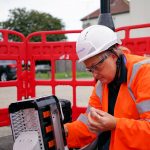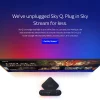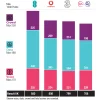Ofcom UK Reviews 2GHz Band for Use by Mobile Satellite Services

The UK telecoms regulator has today launched a new ‘Call for Input‘ to help it decide on the future of the 2GHz radio spectrum band (1980-2010MHz and 2170-2200MHz), which could potentially open it up to wider use for providing broadband connectivity to aircraft and drones, direct-to-device services (4G/5G mobile), and or IoT etc.
At present this spectrum is already harmonised across the EU and the UK for Mobile Satellite Services (MSS). Since 2009 the band(s) have been licensed to two satellite operators – Viasat and Echostar – on an exclusive basis, but these are due to expire in May 2027 and so the regulator has decided to explore the potential for alternative uses.
Just to be clear. Viasat currently uses this for their European Aviation Network (EAN) to help provide in-flight WiFi, which launched in 2019 and operates across several airlines. As for Echostar, they use the spectrum for an Internet of Things (IoT) network that extends the reach of Long Range Wireless Network (LoRaWAN) sensors to remotely collect and transmit data across Europe. Suffice to say that both platforms are fairly active.
Advertisement
Despite this, Ofcom are seeking optimal use of the spectrum, which could mean extending / tweaking the existing services or allowing its use by a wider array of services (either exclusively or via spectrum sharing). For example, Viasat told Ofcom it could introduce additional direct-to-device (D2D) use cases alongside its existing EAN service, so there may be some flexibility or expansion possible from the incumbent spectrum holders.
However, for some of the services we mentioned at the top, sharing the spectrum with other users could be difficult (i.e. the risk of interference and not enough spare frequency to be viable). “We are therefore seeking input on the types and mix of services that could be authorised in these frequencies in the future in the UK. We welcome responses by 19th September 2025,” said Ofcom.
The regulator plans to publish their first proposals for the future of this band sometime in 2026.
Mark is a professional technology writer, IT consultant and computer engineer from Dorset (England), he also founded ISPreview in 1999 and enjoys analysing the latest telecoms and broadband developments. Find me on X (Twitter), Mastodon, Facebook, BlueSky, Threads.net and Linkedin.























































Am I correct in thinking that Satellite direct to device mobile services will be limited to only a few devices within sparsely populated areas? Mobile phone antennas are omnidirectional so the phone antenna provides no directional gain, which means the satellite phased array antennas will have to use a very large number of elements to resolve the incoming mobile phone signal; Add to that the fact that the satellites are travelling at 17,000 mph and are unlikely to be directly overhead while passing, so line of site distances might be anything between 500 and 1000 Km.
I can see how satellites would be useful for backhaul and on ships/aircraft, where higher power directional transceivers can be used, but satellite to mobile will very niche and probably limited to rural areas with good uninterrupted line of site to the sky.
ASTS is planning to offer 120mbps per beam, so if you have 100 people under that mean that’s 1.2mbps per device, which is awful.
I suppose there will be some overlapping of beams, but when then and area with any kind of concentration of proof will very quickly become text only.